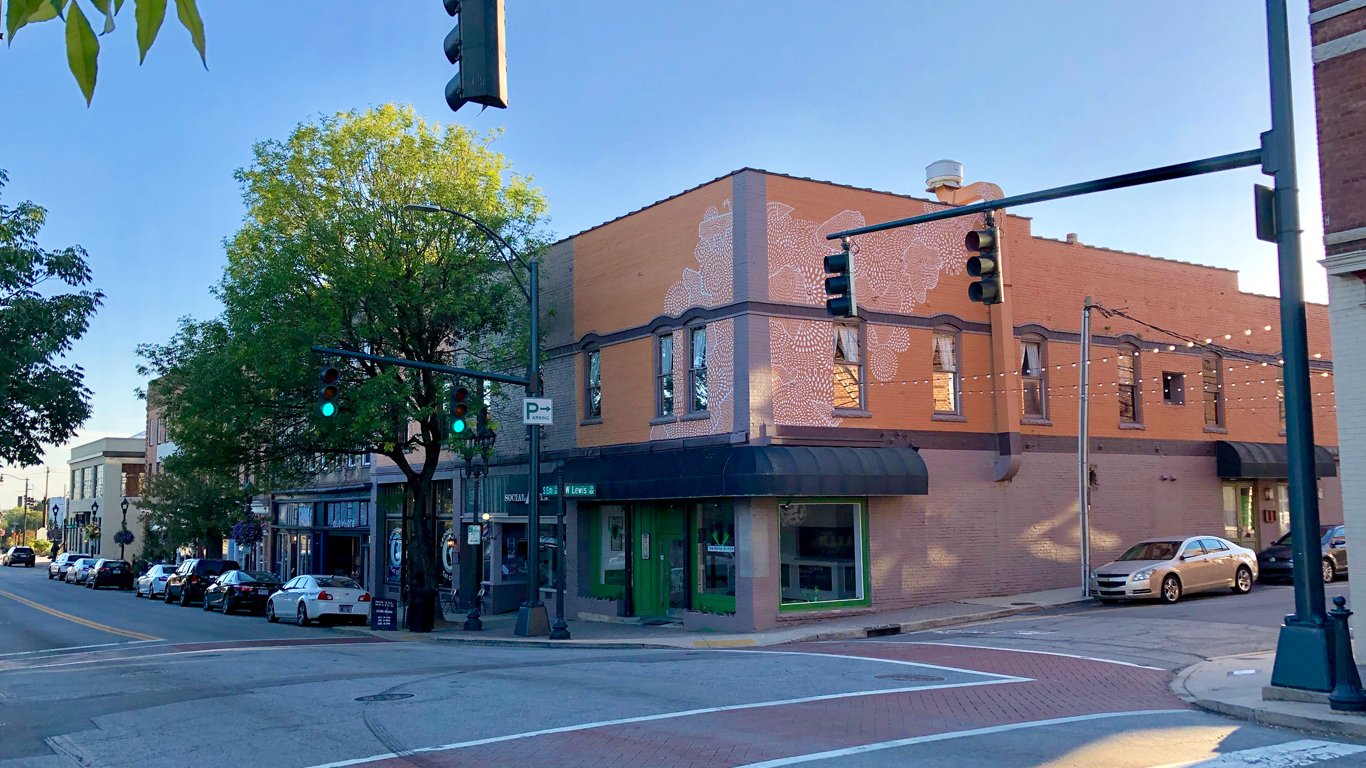

The U.S. has reported more than 79.2 million confirmed COVID-19 cases as of March 29. There have been more than 969,000 reported deaths from COVID-19-related causes — the highest death toll of any country.
The extent of the spread of the novel coronavirus continues to vary considerably from state to state, and from city to city. Even as the number of daily new cases is flattening or even declining in some parts of the country, it is surging at a growing rate in others.
Nationwide, the number of new cases is growing at a steady rate. There were an average of 9.0 daily new coronavirus cases per 100,000 Americans in the week ending March 29, essentially unchanged from the week prior, when there were an average of 10.3 daily new coronavirus cases per 100,000 people.
Metropolitan areas with a high degree of mobility and a large population may be particularly vulnerable to outbreaks. While science and medical professionals are still studying how exactly the virus spreads, experts agree that outbreaks are more likely to occur in group settings where large numbers of people routinely have close contact with one another. Cities with high concentrations of dense spaces such as colleges, correctional facilities, and nursing homes are particularly at risk.
The city with the highest seven-day average of new daily COVID-19 cases per capita is in North Carolina. In the Goldsboro, NC, metro area, there were an average of 116.3 daily new coronavirus cases per 100,000 residents in the week ending March 29, the most of any U.S. metro area. Other cities where COVID-19 is growing the fastest include Lawton, OK; Coeur d’Alene, ID; and Twin Falls, ID.
To determine the metropolitan area in each state where COVID-19 is growing the fastest, 24/7 Wall St. compiled and reviewed data from state and local health departments. We ranked metropolitan areas according to the average number of new daily COVID-19 cases per 100,000 residents in the seven days ending March 29. Data was aggregated from the county level to the metropolitan area level using boundary definitions from the U.S. Census Bureau. Population data used to adjust case and death totals came from the U.S. Census Bureau’s 2019 American Community Survey and are five-year estimates. Unemployment data is from the Bureau of Labor Statistics and is seasonally adjusted.

Alabama: Tuscaloosa
Avg. new daily cases in Tuscaloosa in week ending March 29: 9.8 per 100,000
Avg. new daily cases in Tuscaloosa in week ending March 22: 16.2 per 100,000
COVID-19 cases in Tuscaloosa as of March 29: 67,542 (26,943.4 per 100,000)
Peak pandemic unemployment in Tuscaloosa: 17.1% (April 2020)
Tuscaloosa population: 250,681 (71.7 people per sq. mi.)

Alaska: Anchorage
Avg. new daily cases in Anchorage in week ending March 29: 19.3 per 100,000
Avg. new daily cases in Anchorage in week ending March 22: 20.3 per 100,000
COVID-19 cases in Anchorage as of March 29: 136,318 (34,173.5 per 100,000)
Peak pandemic unemployment in Anchorage: 14.8% (April 2020)
Anchorage population: 398,900 (15.2 people per sq. mi.)
These are all the counties in Alaska where COVID-19 is slowing (and where it’s still getting worse).

Arizona: Phoenix-Mesa-Chandler
Avg. new daily cases in Phoenix in week ending March 29: 10.7 per 100,000
Avg. new daily cases in Phoenix in week ending March 22: 11.8 per 100,000
COVID-19 cases in Phoenix as of March 29: 1,389,705 (29,185.7 per 100,000)
Peak pandemic unemployment in Phoenix: 12.8% (April 2020)
Phoenix population: 4,761,603 (326.9 people per sq. mi.)

Arkansas: Jonesboro
Avg. new daily cases in Jonesboro in week ending March 29: 43.5 per 100,000
Avg. new daily cases in Jonesboro in week ending March 22: 29.1 per 100,000
COVID-19 cases in Jonesboro as of March 29: 45,539 (34,698.8 per 100,000)
Peak pandemic unemployment in Jonesboro: 9.3% (April 2020)
Jonesboro population: 131,241 (89.5 people per sq. mi.)
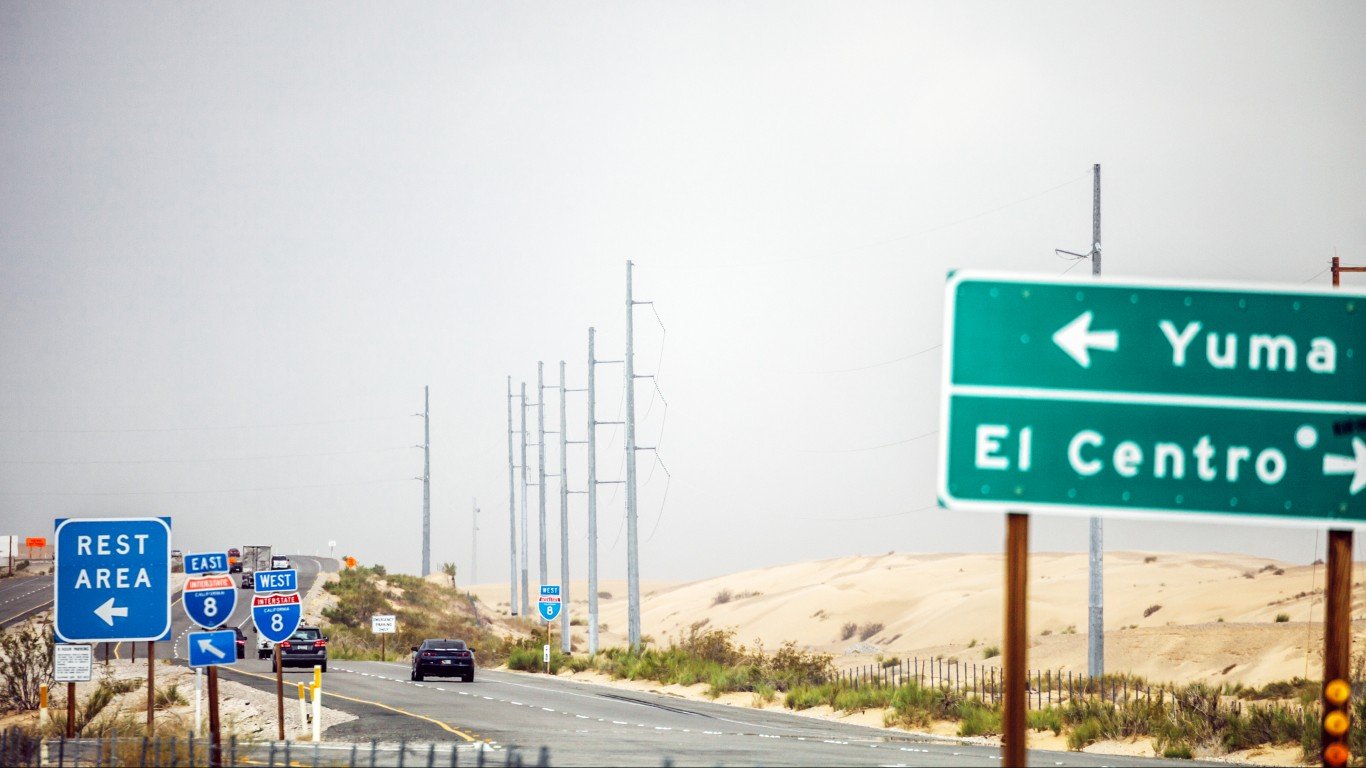
California: El Centro
Avg. new daily cases in El Centro in week ending March 29: 22.7 per 100,000
Avg. new daily cases in El Centro in week ending March 22: 19.7 per 100,000
COVID-19 cases in El Centro as of March 29: 66,362 (36,724.8 per 100,000)
Peak pandemic unemployment in El Centro: 30.0% (April 2020)
El Centro population: 180,701 (43.3 people per sq. mi.)
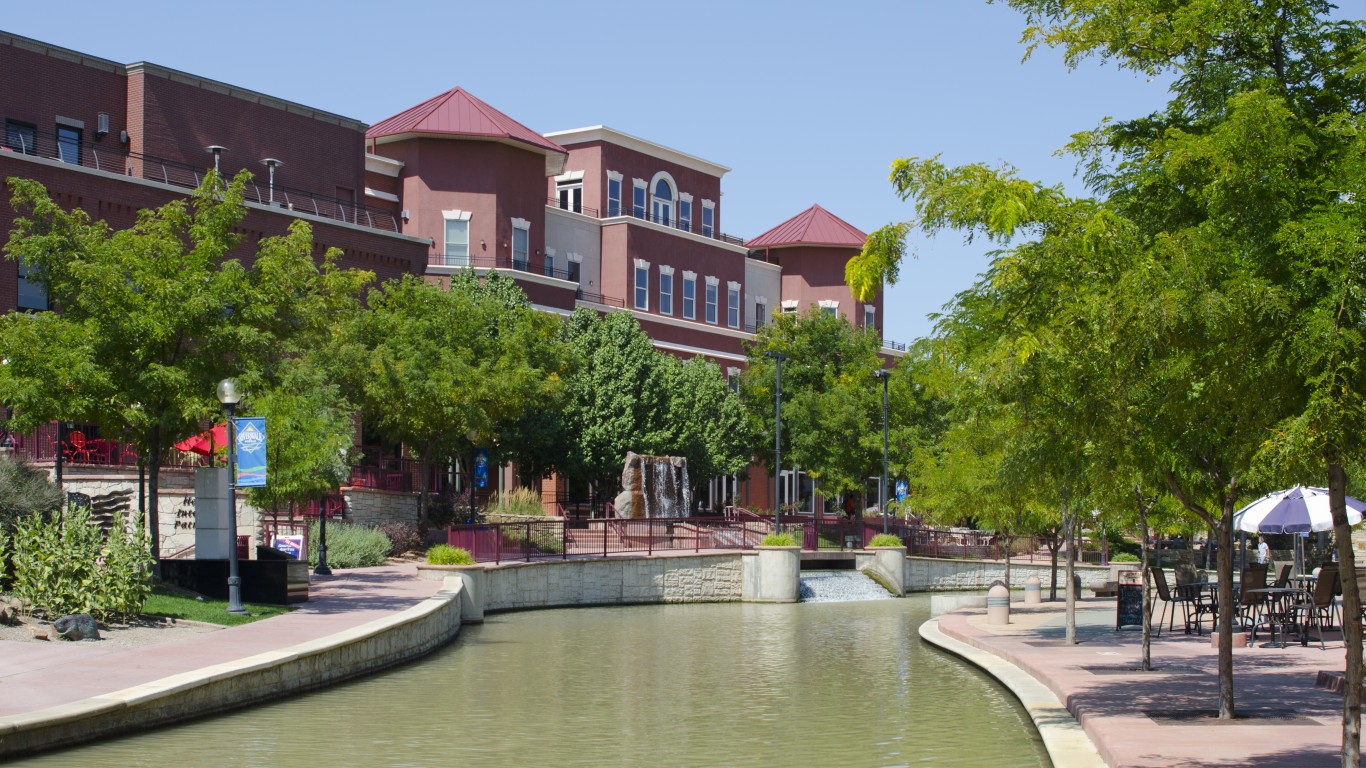
Colorado: Pueblo
Avg. new daily cases in Pueblo in week ending March 29: 35.0 per 100,000
Avg. new daily cases in Pueblo in week ending March 22: 32.1 per 100,000
COVID-19 cases in Pueblo as of March 29: 45,456 (27,386.1 per 100,000)
Peak pandemic unemployment in Pueblo: 11.8% (April 2020)
Pueblo population: 165,982 (69.6 people per sq. mi.)

Connecticut: New Haven-Milford
Avg. new daily cases in New Haven in week ending March 29: 10.9 per 100,000
Avg. new daily cases in New Haven in week ending March 22: 12.3 per 100,000
COVID-19 cases in New Haven as of March 29: 194,335 (22,662.6 per 100,000)
Peak pandemic unemployment in New Haven: 9.5% (July 2020)
New Haven population: 857,513 (1,418.5 people per sq. mi.)

Delaware: Dover
Avg. new daily cases in Dover in week ending March 29: 7.5 per 100,000
Avg. new daily cases in Dover in week ending March 22: 12.3 per 100,000
COVID-19 cases in Dover as of March 29: 50,134 (28,372.5 per 100,000)
Peak pandemic unemployment in Dover: 17.3% (May 2020)
Dover population: 176,699 (301.4 people per sq. mi.)

Florida: Gainesville
Avg. new daily cases in Gainesville in week ending March 29: 7.8 per 100,000
Avg. new daily cases in Gainesville in week ending March 22: 10.6 per 100,000
COVID-19 cases in Gainesville as of March 29: 83,016 (25,638.1 per 100,000)
Peak pandemic unemployment in Gainesville: 9.2% (April 2020)
Gainesville population: 323,799 (138.2 people per sq. mi.)

Georgia: Savannah
Avg. new daily cases in Savannah in week ending March 29: 18.2 per 100,000
Avg. new daily cases in Savannah in week ending March 22: 44.6 per 100,000
COVID-19 cases in Savannah as of March 29: 85,261 (22,086.3 per 100,000)
Peak pandemic unemployment in Savannah: 15.7% (April 2020)
Savannah population: 386,036 (288.1 people per sq. mi.)

Hawaii: Urban Honolulu
Avg. new daily cases in Urban Honolulu in week ending March 29: 7.9 per 100,000
Avg. new daily cases in Urban Honolulu in week ending March 22: 6.8 per 100,000
COVID-19 cases in Urban Honolulu as of March 29: 165,789 (16,834.4 per 100,000)
Peak pandemic unemployment in Urban Honolulu: 20.7% (April 2020)
Urban Honolulu population: 984,821 (1,639.3 people per sq. mi.)
These are all the counties in Hawaii where COVID-19 is slowing (and where it’s still getting worse).
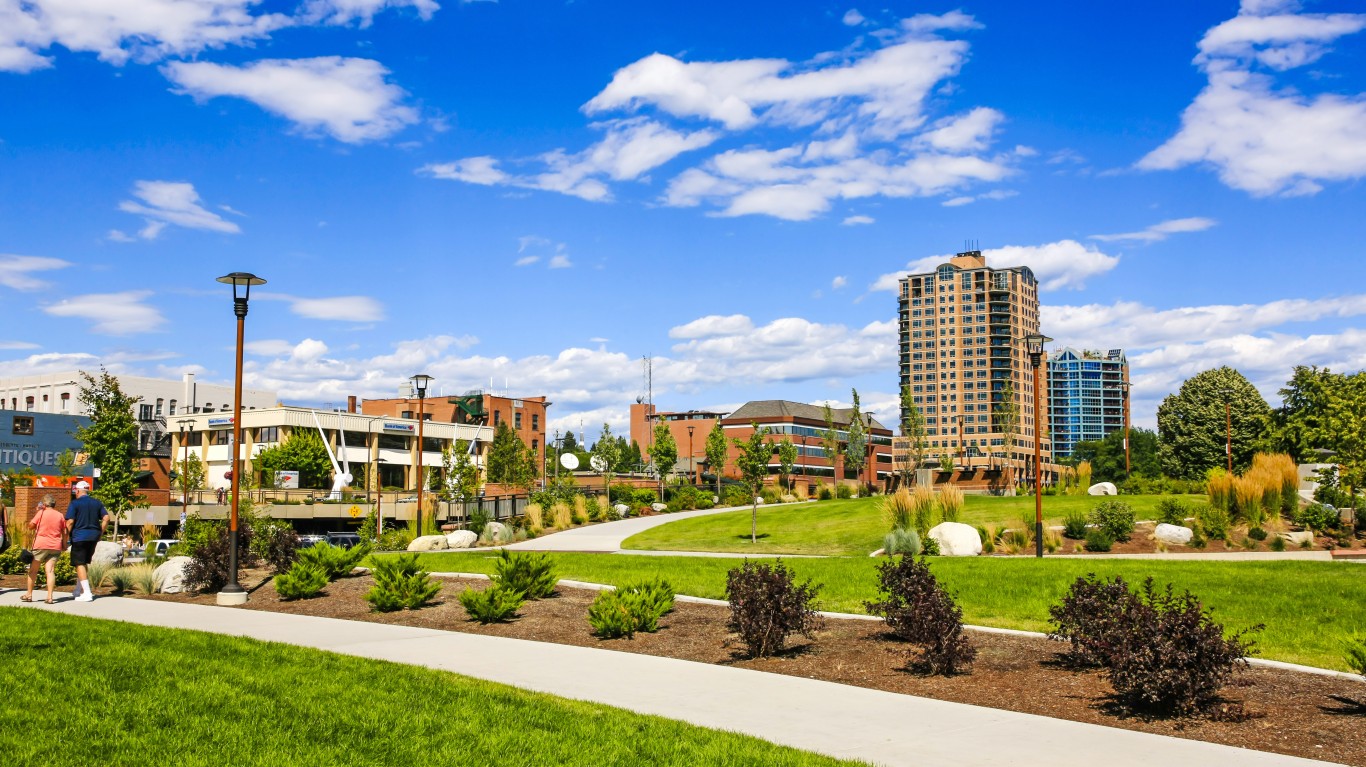
Idaho: Coeur d’Alene
Avg. new daily cases in Coeur d’Alene in week ending March 29: 76.3 per 100,000
Avg. new daily cases in Coeur d’Alene in week ending March 22: 116.6 per 100,000
COVID-19 cases in Coeur d’Alene as of March 29: 41,842 (26,596.4 per 100,000)
Peak pandemic unemployment in Coeur d’Alene: 17.2% (April 2020)
Coeur d’Alene population: 157,322 (126.5 people per sq. mi.)
These are all the counties in Idaho where COVID-19 is slowing (and where it’s still getting worse).
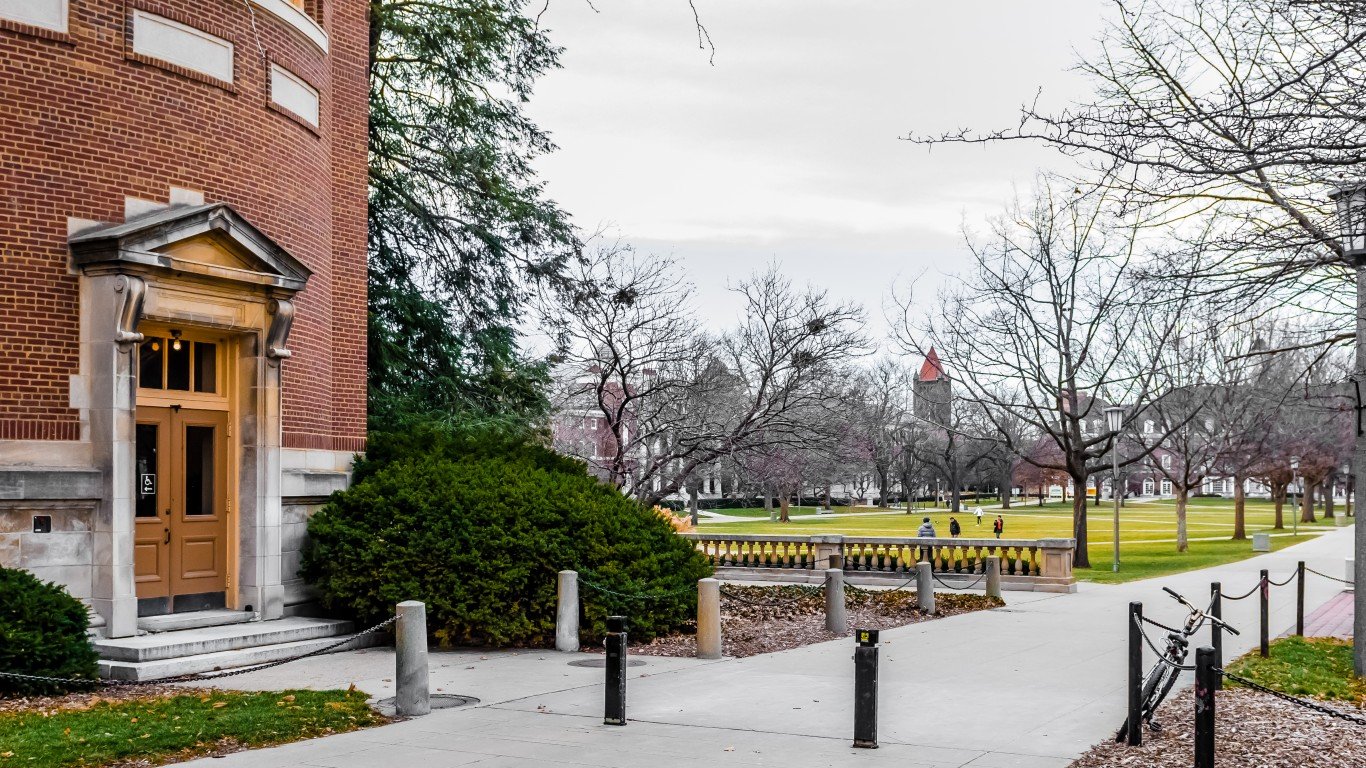
Illinois: Champaign-Urbana
Avg. new daily cases in Champaign in week ending March 29: 12.8 per 100,000
Avg. new daily cases in Champaign in week ending March 22: 6.8 per 100,000
COVID-19 cases in Champaign as of March 29: 66,450 (29,360.7 per 100,000)
Peak pandemic unemployment in Champaign: 12.2% (April 2020)
Champaign population: 226,323 (157.7 people per sq. mi.)
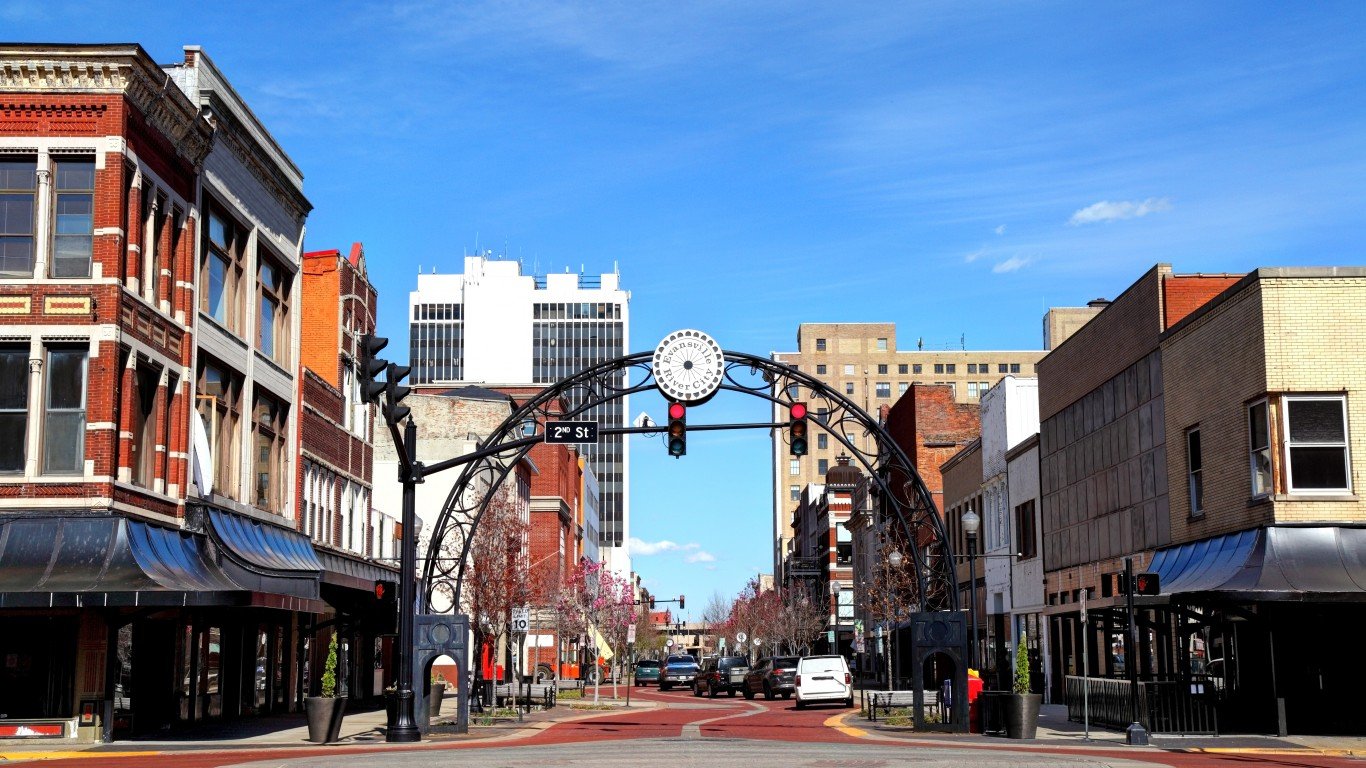
Indiana: Evansville, IN-KY
Avg. new daily cases in Evansville in week ending March 29: 5.0 per 100,000
Avg. new daily cases in Evansville in week ending March 22: 5.6 per 100,000
COVID-19 cases in Evansville as of March 29: 97,747 (31,034.7 per 100,000)
Peak pandemic unemployment in Evansville: 15.2% (April 2020)
Evansville population: 314,960 (215.1 people per sq. mi.)

Iowa: Cedar Rapids
Avg. new daily cases in Cedar Rapids in week ending March 29: 5.4 per 100,000
Avg. new daily cases in Cedar Rapids in week ending March 22: 4.4 per 100,000
COVID-19 cases in Cedar Rapids as of March 29: 63,337 (23,453.3 per 100,000)
Peak pandemic unemployment in Cedar Rapids: 12.7% (April 2020)
Cedar Rapids population: 270,056 (134.4 people per sq. mi.)
These are all the counties in Iowa where COVID-19 is slowing (and where it’s still getting worse).
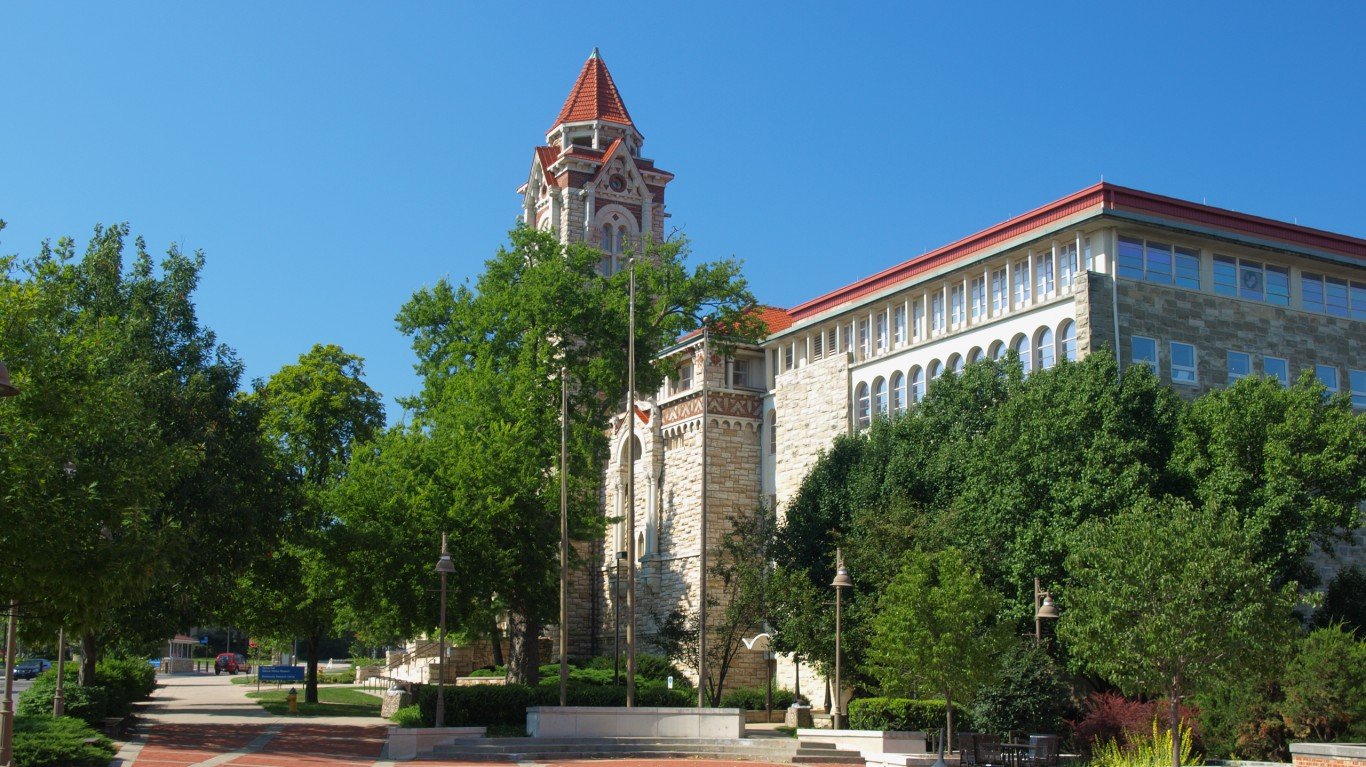
Kansas: Lawrence
Avg. new daily cases in Lawrence in week ending March 29: 5.1 per 100,000
Avg. new daily cases in Lawrence in week ending March 22: 5.2 per 100,000
COVID-19 cases in Lawrence as of March 29: 25,330 (21,057.4 per 100,000)
Peak pandemic unemployment in Lawrence: 12.1% (April 2020)
Lawrence population: 120,290 (263.9 people per sq. mi.)
These are all the counties in Kansas where COVID-19 is slowing (and where it’s still getting worse).
Kentucky: Louisville/Jefferson County, KY-IN
Avg. new daily cases in Louisville/Jefferson County in week ending March 29: 24.0 per 100,000
Avg. new daily cases in Louisville/Jefferson County in week ending March 22: 18.2 per 100,000
COVID-19 cases in Louisville/Jefferson County as of March 29: 353,495 (28,120.1 per 100,000)
Peak pandemic unemployment in Louisville/Jefferson County: 17.4% (April 2020)
Louisville/Jefferson County population: 1,257,088 (388.4 people per sq. mi.)

Louisiana: New Orleans-Metairie
Avg. new daily cases in New Orleans in week ending March 29: 3.3 per 100,000
Avg. new daily cases in New Orleans in week ending March 22: 5.6 per 100,000
COVID-19 cases in New Orleans as of March 29: 305,476 (24,095.4 per 100,000)
Peak pandemic unemployment in New Orleans: 20.0% (April 2020)
New Orleans population: 1,267,777 (396.0 people per sq. mi.)

Maine: Bangor
Avg. new daily cases in Bangor in week ending March 29: 10.8 per 100,000
Avg. new daily cases in Bangor in week ending March 22: 19.2 per 100,000
COVID-19 cases in Bangor as of March 29: 27,200 (17,921.4 per 100,000)
Peak pandemic unemployment in Bangor: 9.6% (April 2020)
Bangor population: 151,774 (44.7 people per sq. mi.)
These are all the counties in Maine where COVID-19 is slowing (and where it’s still getting worse).
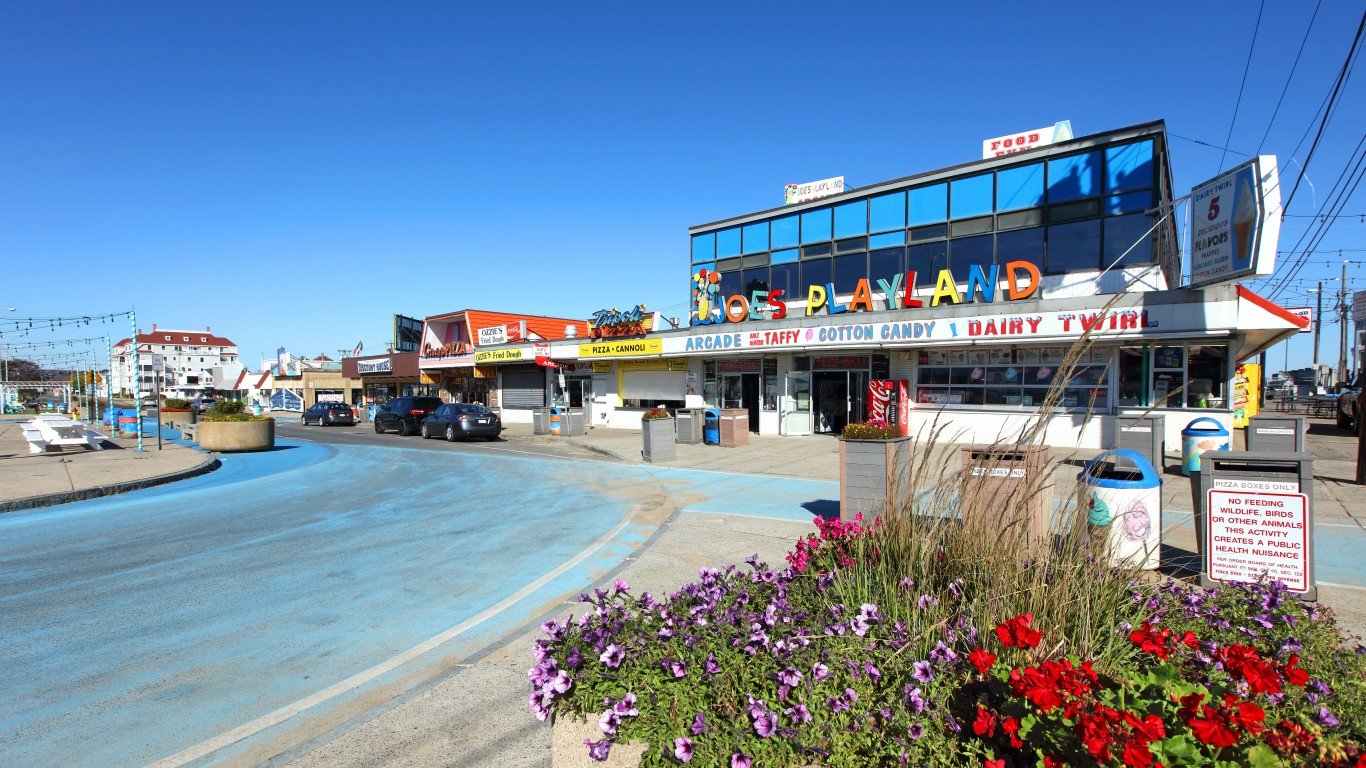
Maryland: Salisbury, MD-DE
Avg. new daily cases in Salisbury in week ending March 29: 5.9 per 100,000
Avg. new daily cases in Salisbury in week ending March 22: 10.2 per 100,000
COVID-19 cases in Salisbury as of March 29: 94,863 (23,456.7 per 100,000)
Peak pandemic unemployment in Salisbury: 16.0% (April 2020)
Salisbury population: 404,417 (192.7 people per sq. mi.)

Massachusetts: Boston-Cambridge-Newton, MA-NH
Avg. new daily cases in Boston in week ending March 29: 11.4 per 100,000
Avg. new daily cases in Boston in week ending March 22: 9.4 per 100,000
COVID-19 cases in Boston as of March 29: 1,076,501 (22,277.0 per 100,000)
Peak pandemic unemployment in Boston: 16.9% (June 2020)
Boston population: 4,832,346 (1,385.7 people per sq. mi.)

Michigan: Ann Arbor
Avg. new daily cases in Ann Arbor in week ending March 29: 14.6 per 100,000
Avg. new daily cases in Ann Arbor in week ending March 22: 10.8 per 100,000
COVID-19 cases in Ann Arbor as of March 29: 74,218 (20,222.9 per 100,000)
Peak pandemic unemployment in Ann Arbor: 15.5% (April 2020)
Ann Arbor population: 367,000 (519.9 people per sq. mi.)

Minnesota: Rochester
Avg. new daily cases in Rochester in week ending March 29: 15.0 per 100,000
Avg. new daily cases in Rochester in week ending March 22: 23.4 per 100,000
COVID-19 cases in Rochester as of March 29: 56,557 (25,947.9 per 100,000)
Peak pandemic unemployment in Rochester: 9.7% (May 2020)
Rochester population: 217,964 (88.0 people per sq. mi.)
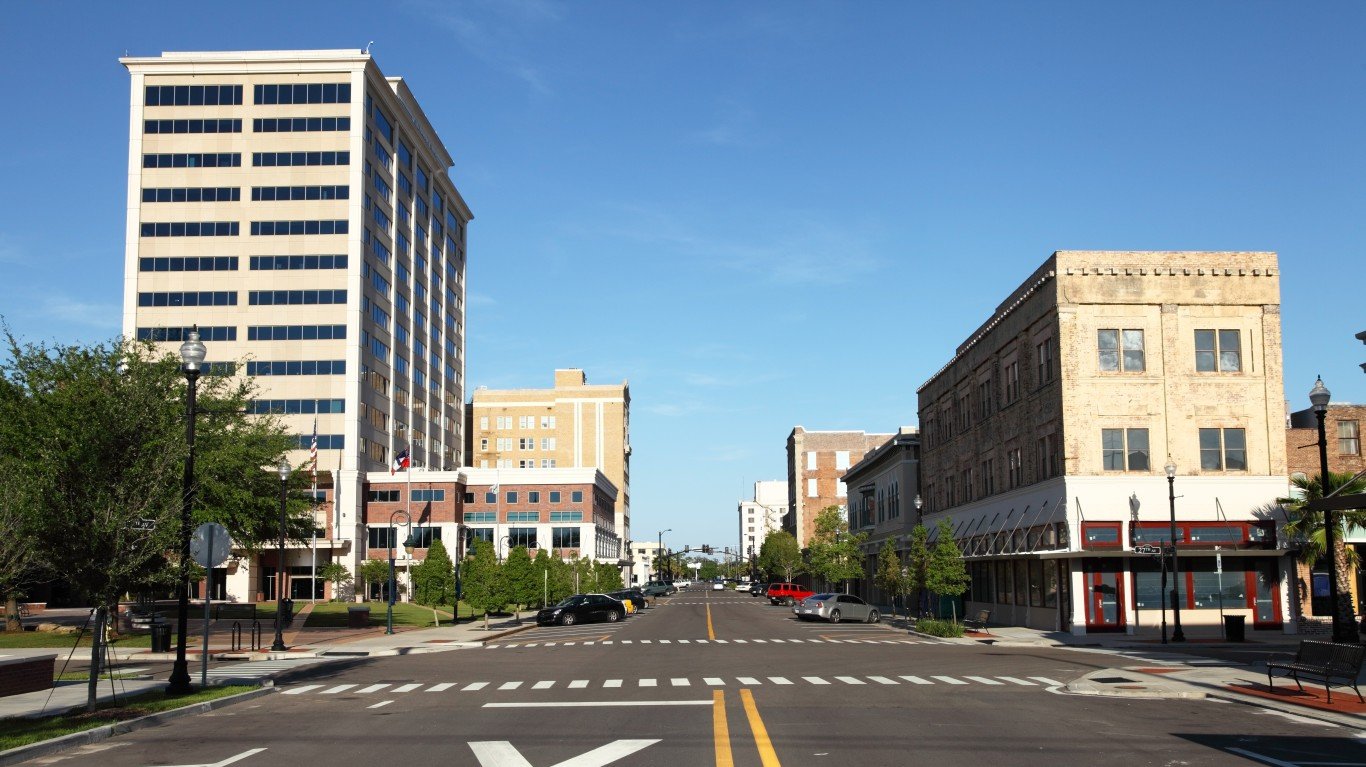
Mississippi: Gulfport-Biloxi
Avg. new daily cases in Gulfport in week ending March 29: 3.2 per 100,000
Avg. new daily cases in Gulfport in week ending March 22: 4.7 per 100,000
COVID-19 cases in Gulfport as of March 29: 107,874 (26,175.7 per 100,000)
Peak pandemic unemployment in Gulfport: 22.3% (April 2020)
Gulfport population: 412,115 (186.0 people per sq. mi.)

Missouri: St. Joseph, MO-KS
Avg. new daily cases in St. Joseph in week ending March 29: 9.4 per 100,000
Avg. new daily cases in St. Joseph in week ending March 22: 25.9 per 100,000
COVID-19 cases in St. Joseph as of March 29: 32,102 (25,442.8 per 100,000)
Peak pandemic unemployment in St. Joseph: 7.5% (April 2020)
St. Joseph population: 126,173 (76.2 people per sq. mi.)

Montana: Missoula
Avg. new daily cases in Missoula in week ending March 29: 5.2 per 100,000
Avg. new daily cases in Missoula in week ending March 22: 7.3 per 100,000
COVID-19 cases in Missoula as of March 29: 27,222 (23,205.4 per 100,000)
Peak pandemic unemployment in Missoula: 13.3% (April 2020)
Missoula population: 117,309 (45.2 people per sq. mi.)

Nebraska: Lincoln
Avg. new daily cases in Lincoln in week ending March 29: 4.9 per 100,000
Avg. new daily cases in Lincoln in week ending March 22: 4.7 per 100,000
COVID-19 cases in Lincoln as of March 29: 81,330 (24,620.9 per 100,000)
Peak pandemic unemployment in Lincoln: 9.6% (April 2020)
Lincoln population: 330,329 (234.4 people per sq. mi.)

Nevada: Las Vegas-Henderson-Paradise
Avg. new daily cases in Las Vegas in week ending March 29: 38.7 per 100,000
Avg. new daily cases in Las Vegas in week ending March 22: 95.3 per 100,000
COVID-19 cases in Las Vegas as of March 29: 534,168 (24,480.6 per 100,000)
Peak pandemic unemployment in Las Vegas: 34.2% (April 2020)
Las Vegas population: 2,182,004 (276.5 people per sq. mi.)
These are all the counties in Nevada where COVID-19 is slowing (and where it’s still getting worse).

New Hampshire: Manchester-Nashua
Avg. new daily cases in Manchester in week ending March 29: 8.6 per 100,000
Avg. new daily cases in Manchester in week ending March 22: 6.6 per 100,000
COVID-19 cases in Manchester as of March 29: 96,602 (23,388.3 per 100,000)
Peak pandemic unemployment in Manchester: 17.5% (April 2020)
Manchester population: 413,035 (471.4 people per sq. mi.)

New Jersey: Trenton-Princeton
Avg. new daily cases in Trenton in week ending March 29: 8.9 per 100,000
Avg. new daily cases in Trenton in week ending March 22: 11.1 per 100,000
COVID-19 cases in Trenton as of March 29: 75,681 (20,569.8 per 100,000)
Peak pandemic unemployment in Trenton: 12.4% (June 2020)
Trenton population: 367,922 (1,638.4 people per sq. mi.)

New Mexico: Farmington
Avg. new daily cases in Farmington in week ending March 29: 9.4 per 100,000
Avg. new daily cases in Farmington in week ending March 22: 8.2 per 100,000
COVID-19 cases in Farmington as of March 29: 40,584 (32,078.4 per 100,000)
Peak pandemic unemployment in Farmington: 14.5% (July 2020)
Farmington population: 126,515 (22.9 people per sq. mi.)
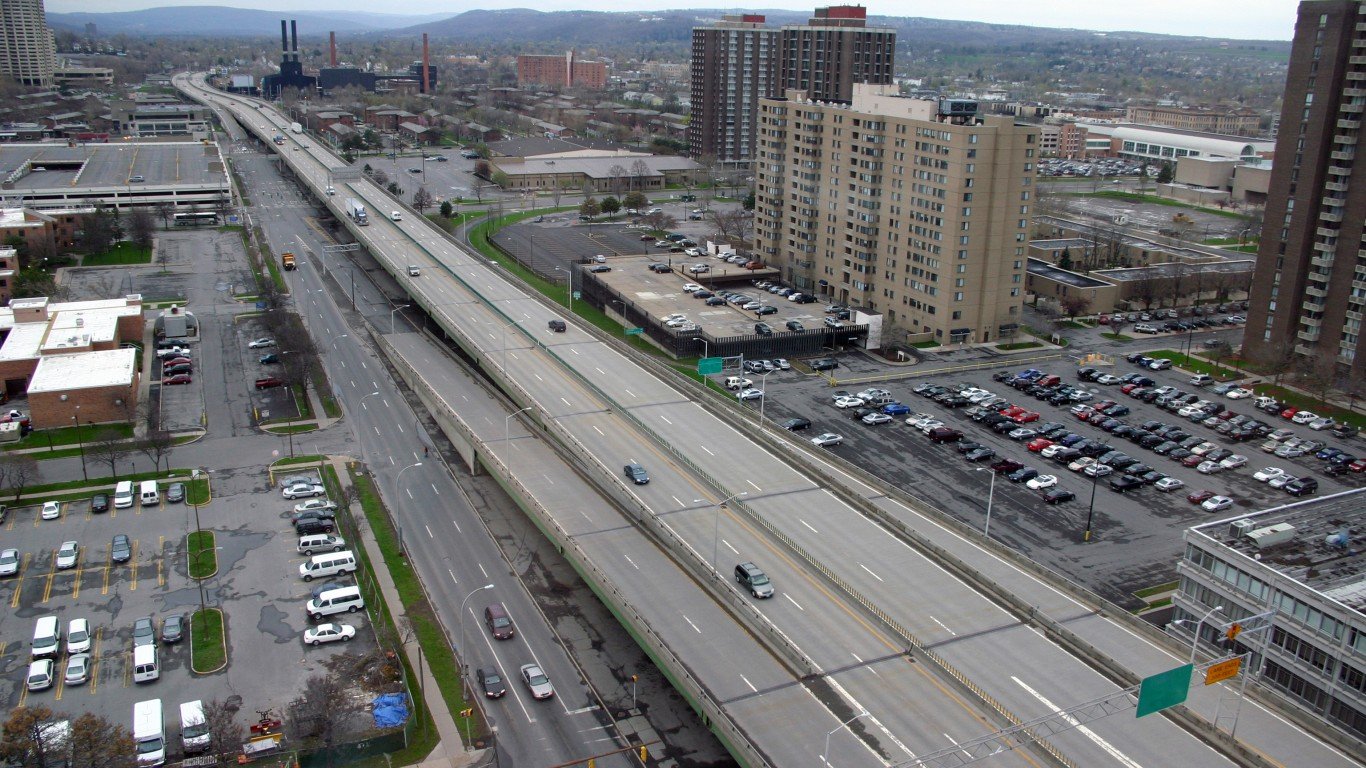
New York: Syracuse
Avg. new daily cases in Syracuse in week ending March 29: 36.0 per 100,000
Avg. new daily cases in Syracuse in week ending March 22: 24.5 per 100,000
COVID-19 cases in Syracuse as of March 29: 149,934 (22,981.3 per 100,000)
Peak pandemic unemployment in Syracuse: 16.7% (April 2020)
Syracuse population: 652,416 (273.6 people per sq. mi.)
North Carolina: Goldsboro
Avg. new daily cases in Goldsboro in week ending March 29: 116.3 per 100,000
Avg. new daily cases in Goldsboro in week ending March 22: 47.2 per 100,000
COVID-19 cases in Goldsboro as of March 29: 29,613 (23,958.2 per 100,000)
Peak pandemic unemployment in Goldsboro: 10.1% (April 2020)
Goldsboro population: 123,603 (223.5 people per sq. mi.)
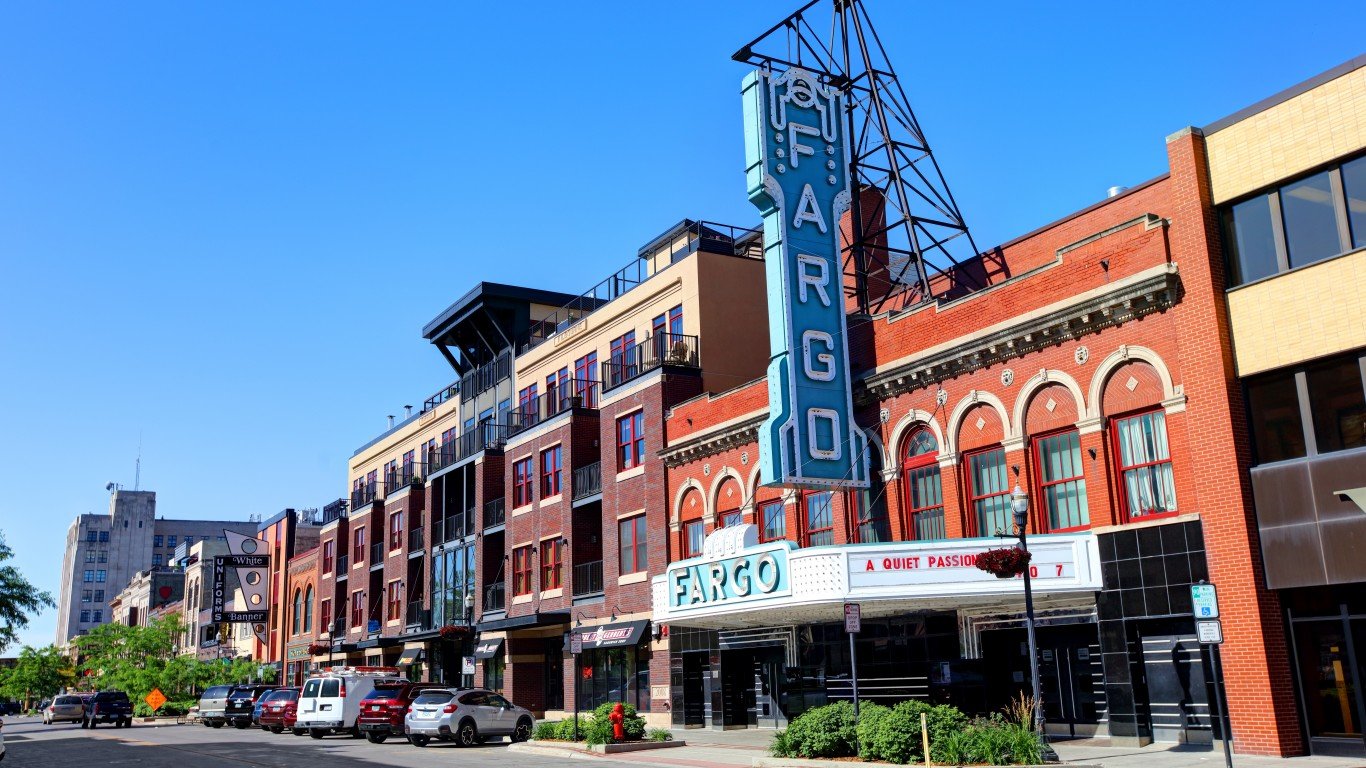
North Dakota: Fargo, ND-MN
Avg. new daily cases in Fargo in week ending March 29: 3.6 per 100,000
Avg. new daily cases in Fargo in week ending March 22: 12.1 per 100,000
COVID-19 cases in Fargo as of March 29: 78,556 (32,674.4 per 100,000)
Peak pandemic unemployment in Fargo: 7.7% (April 2020)
Fargo population: 240,421 (85.5 people per sq. mi.)

Ohio: Cincinnati, OH-KY-IN
Avg. new daily cases in Cincinnati in week ending March 29: 9.3 per 100,000
Avg. new daily cases in Cincinnati in week ending March 22: 10.3 per 100,000
COVID-19 cases in Cincinnati as of March 29: 536,014 (24,345.0 per 100,000)
Peak pandemic unemployment in Cincinnati: 14.5% (April 2020)
Cincinnati population: 2,201,741 (483.6 people per sq. mi.)
These are all the counties in Ohio where COVID-19 is slowing (and where it’s still getting worse).

Oklahoma: Lawton
Avg. new daily cases in Lawton in week ending March 29: 91.3 per 100,000
Avg. new daily cases in Lawton in week ending March 22: 54.8 per 100,000
COVID-19 cases in Lawton as of March 29: 34,283 (26,863.3 per 100,000)
Peak pandemic unemployment in Lawton: 19.5% (April 2020)
Lawton population: 127,620 (75.0 people per sq. mi.)

Oregon: Bend
Avg. new daily cases in Bend in week ending March 29: 9.2 per 100,000
Avg. new daily cases in Bend in week ending March 22: 11.8 per 100,000
COVID-19 cases in Bend as of March 29: 45,781 (24,580.3 per 100,000)
Peak pandemic unemployment in Bend: 18.3% (April 2020)
Bend population: 186,251 (61.7 people per sq. mi.)
These are all the counties in Oregon where COVID-19 is slowing (and where it’s still getting worse).

Pennsylvania: State College
Avg. new daily cases in State College in week ending March 29: 6.0 per 100,000
Avg. new daily cases in State College in week ending March 22: 6.5 per 100,000
COVID-19 cases in State College as of March 29: 35,044 (21,637.4 per 100,000)
Peak pandemic unemployment in State College: 10.4% (April 2020)
State College population: 161,960 (145.9 people per sq. mi.)

Rhode Island: Providence-Warwick, RI-MA
Avg. new daily cases in Providence in week ending March 29: 15.9 per 100,000
Avg. new daily cases in Providence in week ending March 22: 16.1 per 100,000
COVID-19 cases in Providence as of March 29: 481,742 (29,769.0 per 100,000)
Peak pandemic unemployment in Providence: 18.5% (April 2020)
Providence population: 1,618,268 (1,019.8 people per sq. mi.)
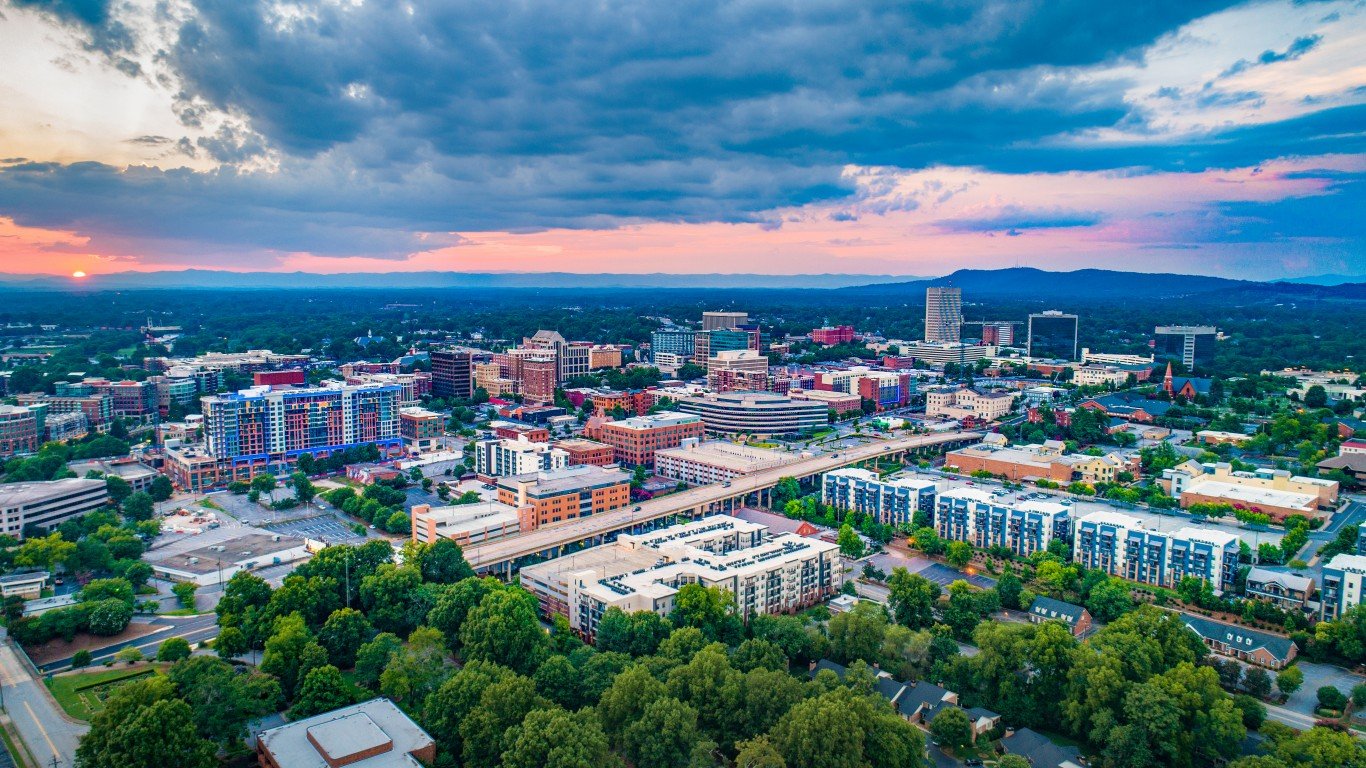
South Carolina: Greenville-Anderson
Avg. new daily cases in Greenville in week ending March 29: 5.9 per 100,000
Avg. new daily cases in Greenville in week ending March 22: 2.8 per 100,000
COVID-19 cases in Greenville as of March 29: 293,931 (32,806.9 per 100,000)
Peak pandemic unemployment in Greenville: 12.5% (April 2020)
Greenville population: 895,942 (330.5 people per sq. mi.)
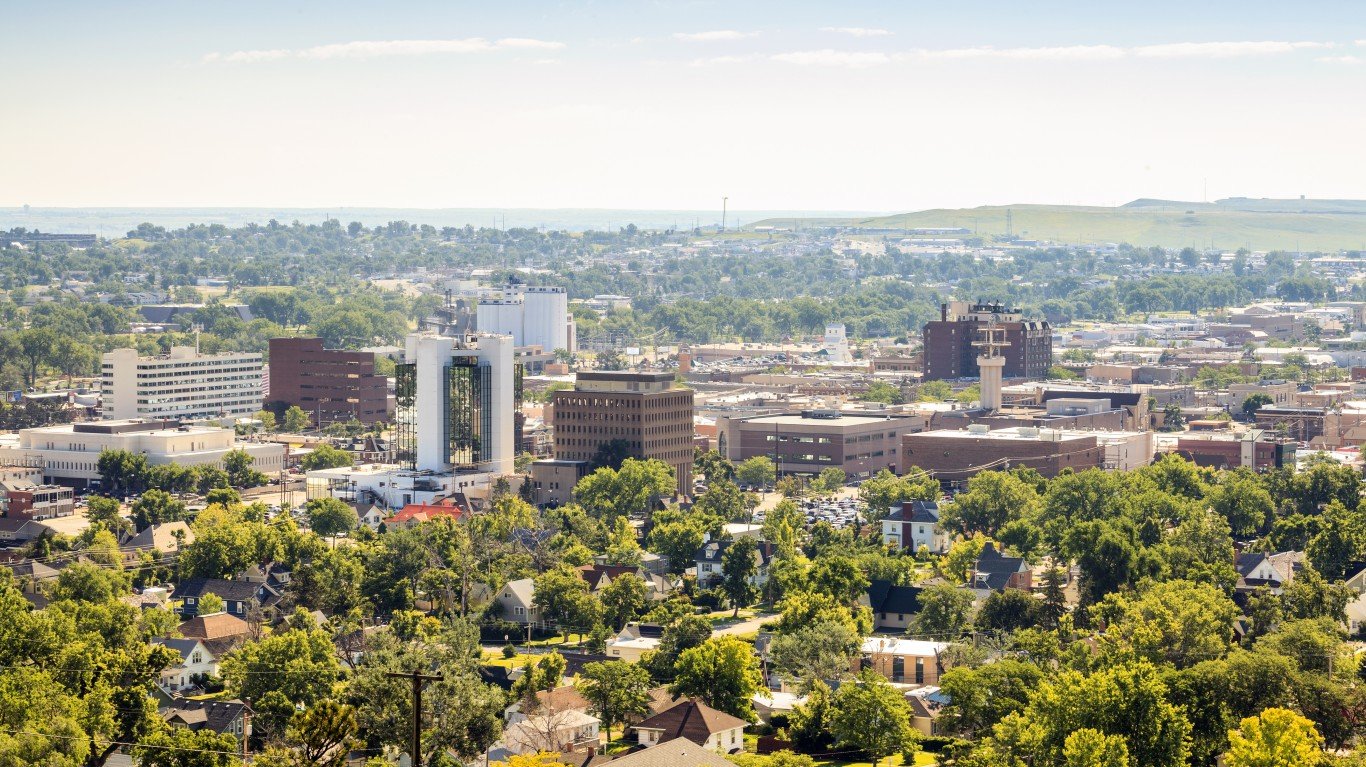
South Dakota: Rapid City
Avg. new daily cases in Rapid City in week ending March 29: 4.7 per 100,000
Avg. new daily cases in Rapid City in week ending March 22: 5.5 per 100,000
COVID-19 cases in Rapid City as of March 29: 39,629 (28,633.3 per 100,000)
Peak pandemic unemployment in Rapid City: 13.8% (April 2020)
Rapid City population: 138,402 (22.2 people per sq. mi.)

Tennessee: Clarksville, TN-KY
Avg. new daily cases in Clarksville in week ending March 29: 15.3 per 100,000
Avg. new daily cases in Clarksville in week ending March 22: 21.1 per 100,000
COVID-19 cases in Clarksville as of March 29: 73,663 (24,597.8 per 100,000)
Peak pandemic unemployment in Clarksville: 16.6% (April 2020)
Clarksville population: 299,470 (138.8 people per sq. mi.)

Texas: Midland
Avg. new daily cases in Midland in week ending March 29: 49.7 per 100,000
Avg. new daily cases in Midland in week ending March 22: 78.0 per 100,000
COVID-19 cases in Midland as of March 29: 40,710 (23,421.3 per 100,000)
Peak pandemic unemployment in Midland: 12.8% (May 2020)
Midland population: 173,816 (95.8 people per sq. mi.)
These are all the counties in Texas where COVID-19 is slowing (and where it’s still getting worse).

Utah: Salt Lake City
Avg. new daily cases in Salt Lake City in week ending March 29: 5.8 per 100,000
Avg. new daily cases in Salt Lake City in week ending March 22: 5.6 per 100,000
COVID-19 cases in Salt Lake City as of March 29: 362,363 (30,170.7 per 100,000)
Peak pandemic unemployment in Salt Lake City: 11.3% (April 2020)
Salt Lake City population: 1,201,043 (156.3 people per sq. mi.)
These are all the counties in Utah where COVID-19 is slowing (and where it’s still getting worse).

Vermont: Burlington-South Burlington
Avg. new daily cases in Burlington in week ending March 29: 20.7 per 100,000
Avg. new daily cases in Burlington in week ending March 22: 16.3 per 100,000
COVID-19 cases in Burlington as of March 29: 41,043 (18,759.6 per 100,000)
Peak pandemic unemployment in Burlington: 14.8% (April 2020)
Burlington population: 218,784 (174.7 people per sq. mi.)

Virginia: Lynchburg
Avg. new daily cases in Lynchburg in week ending March 29: 24.6 per 100,000
Avg. new daily cases in Lynchburg in week ending March 22: 35.7 per 100,000
COVID-19 cases in Lynchburg as of March 29: 59,887 (22,888.0 per 100,000)
Peak pandemic unemployment in Lynchburg: 10.6% (April 2020)
Lynchburg population: 261,652 (123.8 people per sq. mi.)

Washington: Longview
Avg. new daily cases in Longview in week ending March 29: 19.3 per 100,000
Avg. new daily cases in Longview in week ending March 22: 26.4 per 100,000
COVID-19 cases in Longview as of March 29: 22,592 (21,157.9 per 100,000)
Peak pandemic unemployment in Longview: 16.5% (April 2020)
Longview population: 106,778 (93.7 people per sq. mi.)

West Virginia: Huntington-Ashland, WV-KY-OH
Avg. new daily cases in Huntington in week ending March 29: 10.5 per 100,000
Avg. new daily cases in Huntington in week ending March 22: 15.4 per 100,000
COVID-19 cases in Huntington as of March 29: 108,342 (29,942.6 per 100,000)
Peak pandemic unemployment in Huntington: 17.2% (April 2020)
Huntington population: 361,832 (144.7 people per sq. mi.)

Wisconsin: Janesville-Beloit
Avg. new daily cases in Janesville in week ending March 29: 12.7 per 100,000
Avg. new daily cases in Janesville in week ending March 22: 9.0 per 100,000
COVID-19 cases in Janesville as of March 29: 42,650 (26,302.5 per 100,000)
Peak pandemic unemployment in Janesville: 16.3% (April 2020)
Janesville population: 162,152 (225.8 people per sq. mi.)
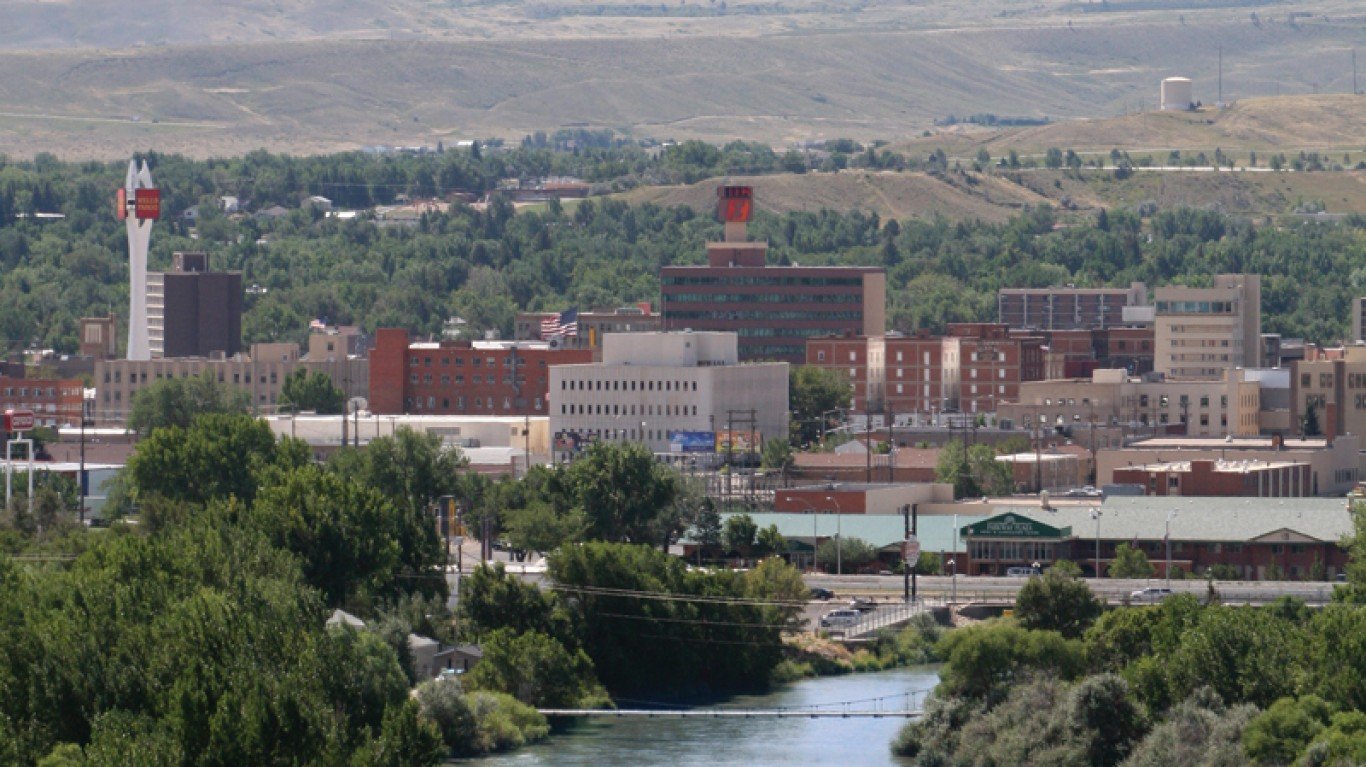
Wyoming: Casper
Avg. new daily cases in Casper in week ending March 29: 4.3 per 100,000
Avg. new daily cases in Casper in week ending March 22: 3.6 per 100,000
COVID-19 cases in Casper as of March 29: 22,232 (27,674.8 per 100,000)
Peak pandemic unemployment in Casper: 12.6% (April 2020)
Casper population: 80,333 (15.0 people per sq. mi.)
Click here to see all coronavirus data for every state.
Essential Tips for Investing: Sponsored
A financial advisor can help you understand the advantages and disadvantages of investment properties. Finding a qualified financial advisor doesn’t have to be hard. SmartAsset’s free tool matches you with up to three financial advisors who serve your area, and you can interview your advisor matches at no cost to decide which one is right for you. If you’re ready to find an advisor who can help you achieve your financial goals, get started now.
Investing in real estate can diversify your portfolio. But expanding your horizons may add additional costs. If you’re an investor looking to minimize expenses, consider checking out online brokerages. They often offer low investment fees, helping you maximize your profit.
Thank you for reading! Have some feedback for us?
Contact the 24/7 Wall St. editorial team.

